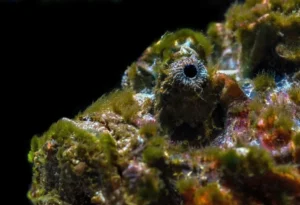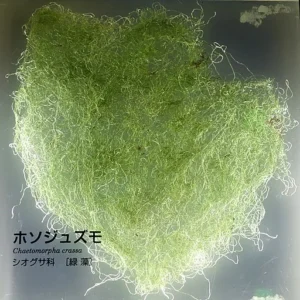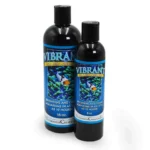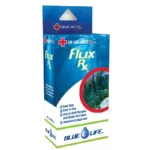Algae will occur in your saltwater aquarium, there’s just no getting away from that.
Some algae occur naturally and some will be introduced by you, via live rocks and coral frags.
Some algae are beneficial and some can and will be eaten by your fish and invertebrates.
Other algae, though can be invasive and if left uncontrolled will take over your aquarium and smother and kill your corals.
To control algae in a saltwater aquarium you need to be aware of the types of algae you are likely to encounter and how to prevent them from getting out of hand.
Table of Contents

Types of Algae in a Saltwater Aquarium
Lets look at the most common types of algae you will encounter in a saltwater aquarium:-
Diatoms
Diatoms will arise in nearly all new tanks after the nitrogen cycle has completed and appear as a brown powdery substance on the sandbed, rocks and glass.
They are easily removed by glass cleaning and blowing off the sand and rocks with a turkey baster. However, they will quickly return.
Diatoms utilise any available silicates in your system but will eventually die out as silicates deplete over time and other algae arise to out-compete them.
Ceriths, Nerites, Trochus and Astraea snails will eat them and will help keep them to a minimum during the early stages of tank maturation.
Cyanobacteria
Cyanobacteria or ‘red slime algae‘ is not actually algae at all but bacteria. It is usually caused by a number of factors:-
- An imbalance between nitrates and phosphates or levels of either that are too low
- Low flow – Cyanobacteria prefers low flow and often appears in dead spots in an aquarium where food waste and debris accumulate.
- A poor water source such as tap water that contains an excess or harmful nutrients.
Whilst it can be fairly easily removed by siphoning and blacking out your tank for a few days will also remove it. It will return though unless the underlying causes are addressed.
Green Hair Algae
Green hair algae thrive in systems where nutrients are too high, particularly phosphates, and will quickly spread and overwhelm your tank, smothering any corals.
Many fish and invertebrates will eat it and keep it to a minimum but of course, not all are suitable for every aquarium.
Certain tangs, rabbitfish, or algae blennies will happily eat green hair algae, as will hermit crabs, assorted snails, urchins or sea hares.
Bubble Algae

If left unchecked bubble algae will quickly cover rocks and smother any corals. It has even been known to block filter and pump inlets so should be removed as and when it appears.
It is usually introduced to an aquarium on new coral frags so take care to inspect any before adding them to your tank.
It can be manually removed but take care not to burst the bubbles as they may release spores into the aquarium making the problem even worse.
Unfortunately, very few fish will eat it but it does have a natural predator in the Emerald Crab. Be aware though that not all Emerald crabs will eat it and some Emerald crabs may also nibble at corals.
Dinoflagellates
In the early stages, dinoflagellates can easily be confused with cyanobacteria or diatoms as they have a similar appearance.
Typically though they are brownish in appearance, slimy and form protruding strings often with a trapped air bubble at the end.
As dinoflagellates are photosynthetic, blacking out your tank for a few days will remove it but it will return until the underlying causes are addressed.
They are usually caused by low nutrient levels so it’s important to retain a small level of both nitrates and phosphates in your aquarium.
Dictyota

Dictyota is brown branching algae that can have an iridescent blue hue on the upper part of the leaves.
It grows along rocks and can be hard to manually remove. If allowed to grow unchecked it will smother corals.
Some tangs, snails and crabs will eat it but the best way to remove dictyota is to grow competing macroalgae in a refugium which will starve it of nutrients.
Caulerpa
Caulerpa is a macroalgae (or seaweed) used by marine aquarists to out-compete nuisance algae.
Grown in a ‘refugium’ in the sump, caulerpa will utilise any excess nutrients thus starving nuisance algae in the main display tank.
Take care that it does not spread into the main tank, however, as it will compete with corals for space, light, and nutrients.
Chaetomorpha

Chaetomorpha (or Chaeto) is another macroalgae used by marine aquarists in a refugium to out-compete nuisance algae in the main tank.
Easier to grow and contain than Caulerpa, Chaeto is the most common and widely used of the ‘good’ algae used in refugiums.
Causes of Algae in a Saltwater Aquarium
The causes of algae in a saltwater aquarium are many and varied but let’s have a look at the main ones:-
Too Much Light
Most algae are photosynthetic so having lights that are too powerful for your tank or if they are left on too long will lead to algae problems.
Only run your aquarium lights on for 8 – 10 hours per day including ramp up and down periods.
Too High Nutrient Level
The most common cause of algae in a saltwater tank is by allowing nitrates and, or phosphates to get too high.
Try to maintain nitrate levels between 0.025 – 5 ppm and phosphate levels between 0.02 – 0.05 ppm and roughly in the ratio of 1:100.
So, a phosphate level of 0.05ppm would equate to a nitrate level of 5 ppm.
However, this is only a general guide and will vary from aquarium to aquarium.
Too Low Nutrient Level
Beware of letting your nutrient levels drop close to zero as this will lead to an imbalance and is a sure-fire way to get Cyanobacteria or Dinos.
Using Tap Water
Tap water contains varying degrees of dissolved solids, metals, phosphates, and nitrates and should never be used in a salwater aquarium.
Only use RO water with a good salt mix for water changes and RO water only for top-offs.
Introduction From Outside
Many algae species are introduced to an aquarium on live rock or coral frags.
You should make sure any live rock is ‘cured’ before adding it to your aquarium. Likewise, coral frags should be closely examined and dipped if necessary before being added.
Dip in a solution of RO water and 3% hydrogen peroxide if you suspect any algae to be present.
Poor Flow
Having poor or insufficient flow throughout your aquarium can lead to dead spots where detritus may build up. This will lead to a rise in nutrients or will encourage algae, particularly cyanobacteria.
How to Prevent Algae in a Saltwater Aquarium
Now let’s look at the ways you can prevent algae in a saltwater aquarium.
Use a Refugium
If you have a large enough sump you can use a section of it to create a refugium.
In the refugium, you can grow macroalgae like Caulerpa and Cheato that will out-compete nuisance algae and keep it out of the main display tank.
You can also use the refugium to grow and maintain a colony of copepods, the young of which will spread to your main tank as free fish food.
Use RO Water
Only use RO water in conjunction with a good salt mix to fill your aquarium and for water changes. You can find out more about using RO water in our article, Using RO Water In Your Aquarium.
Using RO water means you are not introducing excess nitrates, phosphates and other harmful nutrients every time you do a water change.
Also, only use RO water to top-off daily evaporation loss.
Keep Algae-Eating Fish or Invertebrates

Foxface Rabbit Fish
Many of your tank inhabitants will enjoy making a meal out of some types of algae.
Be aware that they may not eat all algae types and some fish species may not be suitable for your size of aquarium. Tangs grow to a large size and can be aggressive for example.
Be sure to do plenty of research on any fish or critter before adding it to your tank.
Please remember, it’s rarely a good idea to get a particular fish or critter to solve an algae problem unless you can easily provide it with an alternative food source once the algae has gone.
For more guidance, see our article on the Best Clean Up Crew for a Saltwater Tank.
Use Carbon Dosing
Carbon dosing is a method to help control excess nitrates and phosphates in a reef tank. Adding a source of carbon helps feed the beneficial bacteria that consume excess nitrates and phosphates.
For more information see our article, Carbon Dosing in a Reef Tank.
Good Flow Throughout
Make sure you have sufficient flow throughout your aquarium to ensure that no dead spots arise where detritus and algae can build up. One or more wavemakers positioned correctly will ensure a good flow all around the tank.
For more information see our article, Best Saltwater Aquarium Wavemakers.
Regular Testing and Maintenance
You should test your saltwater aquarium on a regular basis with a good test kit to ensure that your nutrient levels are kept in range.
Weekly, or fortnightly 20 – 25% water changes will help reduce nitrates, phosphates and other excess nutrients.
Chemical Methods to Control Algae in a Saltwater Aquarium
As well as the preventative methods above there are a number of chemical methods to control algae in a saltwater aquarium.
To remove Bubble Algae and Dictyota we have had success with Vibrant.
 | Vibrant Reef Aquarium Cleaner | Check pricing on eBay >> |
Be aware that Vibrant will also kill good algae like chaeto so this should be removed from your refugium before beginning treatment.
Do NOT overdose and closely follow the product intructions.
To remove Green Hair Algae and Bryopsis we have had success with Blue Life Flux RX.
 | Blue Life Flux RX | Check pricing on eBay >> |
Again, any Chaeto should be removed from your refugium before beginning treatment.
Do NOT overdose and closely follow the product intructions.
To remove Cyanobacteria we have had success with RedGone.
 | Redgone Cyanobacteria Remover | Check pricing on eBay >> |
Do NOT overdose and closely follow the product intructions.
You may also wish to consider using a UV Sterilizer to help combat nuisance algae. Read our article Why Use a Fish Tank UV Sterilizer to find out more.
Control Algae in a Saltwater Aquarium FAQs
Why does my saltwater tank have so much algae? – There could be several different reasons. Too much light, algae is photosynthetic so do not leave your lights on for more than 7 -10 hours.
An excess of nitrates and phosphates will also lead to algae problems.
How do I reduce algae in my saltwater tank? – One of the best ways is to keep algae-eating fish or invertebrates. Many snails and hermit crabs love algae, as do many fish, such as tangs and rabbit fish.
Always use RO water as this is free from excess nitrates, phosphates, and dissolved solids in tap water.
What is the best algae eater for saltwater tanks? – Conches and snails like the Turbo and Cerith are great for keeping algae at bay on the rocks and sandbed.
A Foxface Rabbitfish will devour most types of algae as will many of the Tang species.
